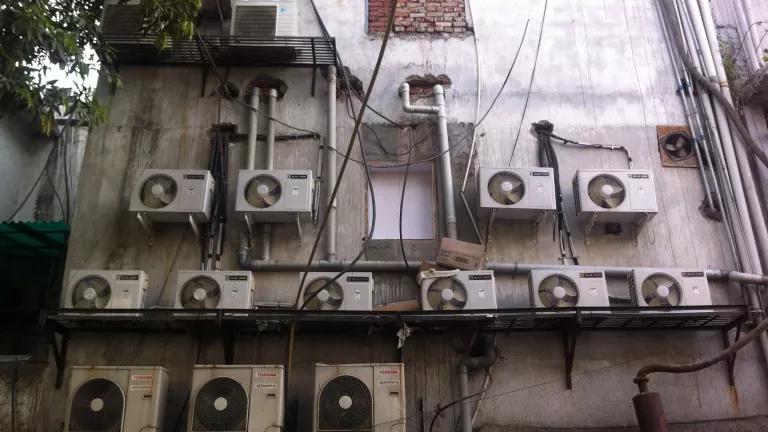
One aspect of rebuilding bring a relatively small silver lining, though it's hidden from view because of the massive amount of work to be done and the pain caused for families with damaged homes. But if fully appreciated, it could lead to greater assistance for the many homeowners and renters facing repairs and improvements.
Consider what happened in 2005 when many thousands of residents in New Orleans faced rebuilding after Hurricane Katrina. Many added new insulation when rebuilding walls, air-sealed around windows, installed new air conditioners and bought new refrigerators. Some customers selected ENERGY STAR® refrigerators and air conditioners, but all new appliances were substantially more energy efficient in 2005 than the average models replaced, thanks to federal efficiency standards that drive innovation among manufacturers. Refrigerators in 2005 used about 40 percent less energy than in 1987 and cost about 25 percent less, on average. (See ACEEE's Better Appliances Report).
What happened next? Average residential customer energy usage across New Orleans declined by almost 10 percent in 2007 from the pre-Katrina baseline. A full evaluation report showed the per-household decline attributable to new air conditioners, new refrigerators, and better insulated homes (separate from total usage reduction across the city from population decline).
Utilities can pay customers for efficiency. Greater energy efficiency in homes and buildings means the utility can avoid very real costs to generate and deliver power that would otherwise be wasted. Especially when considered over a long planning horizon, the utility saves when it can do more with existing resources, and all utility customers benefit. Because of these benefits, utilities operate efficiency programs helping customers purchase high-efficiency air conditioners and refrigerators, insulate walls, and the like.
In a city in recovery mode, like Houston after Hurricane Harvey, support from utility programs could be valuable to customers facing expensive repairs. But these incentives are also investments for the utility in a better system.
The opportunity in Houston

Recent estimates suggest about 100,000 homes and 15,000 apartments in Houston were damaged by flood, including about 30,000 houses completely destroyed. If 100,000 residential customers could achieve an average of 20% energy savings from rebuilding, that could save about 2.6 billion kilowatt hours of electricity over 10 years. (See Note 1 below for the math.)
The opportunity goes beyond homes. Reports suggest about 50 schools in Houston were severely damaged. Utility incentives can help with high-efficiency heating and cooling systems and lighting controls that not only save taxpayer funds through lower utility bills for the schools but also can improve the learning environment for students and teachers.
Because of the high value of efficiency, the distribution utility in Houston, Centerpoint, has for several years operated a set of efficiency programs overseen by the Texas Public Utilities Commission. I would argue the programs are too small and reach too few customers, but reports verify they are cost-effective and great investments for the utility – they saved over $2 for the utility for every $1 of expense. (See most recent report here).
Pre-Disaster Planning for Recovery
The high value of capturing efficiency in the rebuilding effort shows why pre-disaster planning should include an assessment of utility efficiency programs and how programs fit into disaster recovery.
Here are several specific points for the planning process:
- The first, most important step is to assure a robust portfolio of utility efficiency programs are operational at all times. Implementing a program during disaster recovery would be very difficult -- families are in need of immediate help and the utility is likely dealing with emergency repairs and reconnections. Maintaining a portfolio of programs also works to manage administrative and operational costs -- recent analysis by Lawrence Berkeley Laboratories of programs across 36 states shows costs decline as programs mature. (See LBL's recent report, which also shows efficiency as a very low cost resource.)
- Funding for programs should be flexible to handle the increases expected following a disaster.
- For efficiency incentives that apply to in-home repairs (such as adding insulation and air sealing), program designers should consider using a before/after energy rating to approve the project, rather than a manual inspection of the work, since performing inspections during disaster recovery (and massive rebuilding) could present difficulties for inspectors and customers. See DOE report here on role of energy ratings as a compliance path for building codes.
- Outreach to customers will be vital to assure customers and contractors and insurers are aware of the utility offerings before re-building occurs.
Immediately following Hurricane Harvey, several news stories highlighted how Houston-area utilities were able to keep power on and restore power quickly to those who lost it (see stories in Public Utilities Fortnightly and in the Houston Chronicle). This meant power stayed on for Houston hospitals, shelters, police stations, and apartment buildings, protecting families. When the next phase of recovery occurs -- rebuilding -- utilities can serve a very important role by helping customers make their homes, apartments, schools, and offices more affordable and more resilient for many years.
Footnote 1. Here's the math for estimated energy savings. Assuming 100,000 homes with average 13,000 kwh/yr, 20% savings equals 260 million kwh per year. Assuming 10 years persistence equals 2.6 billion kwh. Is 20% savings a reasonable average? A “most efficient” Energy Star heat pump air conditioner can save 30% over a baseline model on the market, and home cooling is often 30% of total home energy use in Houston climate zone. (See Energy Star savings calculator). When coupled with air sealing and insulation, savings could exceed 30% of total household energy use. See LBL Home Energy Saver. A newly built home (to replace destroyed homes) conforming to 2015 IECC energy code is likely to be 40% more energy efficient (see chart here) than a home built before 2006, or more considering Houston climate zone. I included effects of electric heat pump on cooling, but did not count benefits of displacing a furnace for space.



